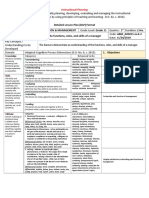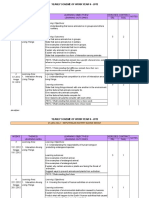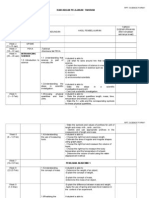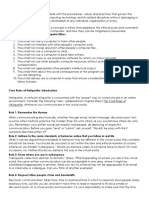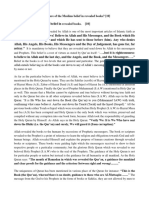Scheme of Work 2012 Science Form 2
Scheme of Work 2012 Science Form 2
Uploaded by
salmiza_sabliCopyright:
Available Formats
Scheme of Work 2012 Science Form 2
Scheme of Work 2012 Science Form 2
Uploaded by
salmiza_sabliOriginal Title
Copyright
Available Formats
Share this document
Did you find this document useful?
Is this content inappropriate?
Copyright:
Available Formats
Scheme of Work 2012 Science Form 2
Scheme of Work 2012 Science Form 2
Uploaded by
salmiza_sabliCopyright:
Available Formats
SCHEME OF WORK 2012 SCIENCE FORM 2
CHAPTER 1: THE WORLD THROUGH OUR SENSE Month Week/Date Learning Objectives 1.1 Understanding the sensory organs and their function. 1.2 Understanding the sense of touch. Learning Outcomes A student is able to: identify and relate a sensory organ to its stimulus state the pathway from stimulus to response A student is able to: identify the structure of the human skin involved in stimuli detection state the function of different receptors; pressure, heat, pain draw conclusion on the sensitivity of the skin at different parts of the body towards stimuli.
Week 1 (4/1-6/1) JANUARY Cuti Tahun Baru Cina (23/1 24/1)
Week 2-3 (09/1-20/1)
1.3 Understanding the sense of A student is able to: smell. identify the structure of the nose identify the position of the sensory cells detection of smell
in the
1.4 Understanding the sense of A student is able to: taste identify the different areas of the tongue that response to different taste relate the sense of taste with the sense of smell 1.5 Understanding the sense of A student is able to: hearing identify the structure of the human ear explain the function of the different parts of the ear describe how we hear
SCHEME OF WORK 2012 SCIENCE FORM 2
Month
Week/Date Week 4 (23/1-27/1)
Learning Objectives 1.6 Understanding the sense of sight
Learning Outcomes A student is able to: identify the structure of the human eye explain the functions of the different parts of the eye describe how we see A student is able to: describe the properties of light (reflection, refraction) state the various defects of vision explains ways to correct vision defects state and give examples of the limitation of sight connect stereoscopic and monocular vision with the survival of animals identify the appropriate device to overcome the limitation of sight
1.7 Understanding light and sight
February Cuti Maulidul Rasul (05/02/2012)
Week 5-6 (30/1-10/2)
1.8 Understanding sound and hearing.
A student is able to: describe the properties of sound explain the reflection and absorption of sound explain the defects of hearing explain the ways of rectifying the defects in hearing state the limitation of hearing state the device used to overcome the limitation of hearing explain stereophonic hearing A student is able to: state the stimuli that cause response in plants identify the parts of plants sensitive to specific
February Cuti Thaipusam
Week 7-8 (13/2-24/2)
1.9 Understanding the stimuli and responses in plants. 2
SCHEME OF WORK 2012 SCIENCE FORM 2
(07/02/2012)
stimulus relate the response in plants to their survival
Month
Week/Date
Learning Objectives UJIAN SELARAS 1 5/3-8/3/2012 2.1 Analysing the classes of food.
Learning Outcomes
MARCH Week 9- 10 (27/2-9/3) 2.2 Evaluating the importance of a balanced diet.
A student is able to: explain through examples the classes of food. state the function of each class of food test for starch, glucose, protein, fats. A student is able to: state what a balanced diet is state the factors that must be considered when planning a balanced diet explain how the factors affects a balanced diet state the quantity of energy in each gram of carbohydrates, protein and fats estimates the calories of food taken in a meal plan a balanced diet
CUTI PERTENGAHAN PENGGAL 1 10/3- 18/3/2012
SCHEME OF WORK 2012 SCIENCE FORM 2
Month
Week/Date
Learning Objectives 2.3 Understanding the digestive system in man.
Learning Outcomes
Week 12 (19/3-23/3) MARCH
A student is able to: explain what digestion is identify the parts of the digestive system describe the flow of food particles in the alimentary canal state the functions of the organs in the digestive system describe the process of digestion in the alimentary canal list the end products of digestion of carbohydrate, protein, fats.
2.4 Understanding the process of A student is able to : absorption of digested food. explain the process of absorption of the products of digestion make inference about the absorption of glucose through a Visking tube.
Week 13 (26/3-30/3)
2.5 Understanding the reabsorption of water and defecation.
A student is able to: state how water is reabsorbed in the large intestine explain defecation relate the problem of defecation with eating habits A student is able to: justify the importance of eating nutritious food put in practice good eating habits justify the generous distribution of food to the underprivileged/ needy relate the dining culture of different people
2.6 Put into practice the habits of healthy eating
SCHEME OF WORK 2012 SCIENCE FORM 2
conforming to sensitivities and religious beliefs
CHAPTER 3: BIODIVERSITY Month Week/Date Learning Objectives Learning Outcomes
APRIL
Week 14 (2/4-6/4)
3.1 Understanding variety of living organism and their classification.
A student is able to: explain the diversity of living organism in a habitat classify various animals based on common characteristics classify various plants based on common characteristics explain the importance of biodiversity to the environment
CHAPTER 4: INTERDEPENCE AMONG LIVING ORGANISM AND THE ENVIRONMENT Month APRIL Week/Date Learning Objectives Learning Outcomes
4.1 Analysing the interdependene among living organism.
A student is able to: state what spesies, population and community are state what habitat and ecosystem are
SCHEME OF WORK 2012 SCIENCE FORM 2
identify various habitats in one ecosystem explain through examples the interdependence among living organisms and the environment to create a balanced ecosystem
4.2 Evaluating the interaction between living organism.
Week 15 (9/4-13/4)
A student is able to: list the type of interactions between living organisms explain with examples the interaction between living organism justify the importance of interaction between living organism and the environment explain through examples the advantages and disadvantages of biological control in regulating the number of pest in certain areas A student is able to: explain what producers, consumers and decomposers are combine a few food chains to construct a food web identify the producer, consumer and decomposer in a food web construct a pyramid number from a food chain relate the food web and the pyramid number to energy flow predict the consequences if a certain component of living organisms in the ecosystem is missing
4.3 Synthesizing food web.
APRIL Cuti Hari Keputeraan Sultan Perak
Week 16 (16/4-20/4)
4.4 Analysing photosynthesis.
A student is able to: state what photosynthesis is state the factors required for photosynthesis state the products of photosynthesis 6
SCHEME OF WORK 2012 SCIENCE FORM 2
19/4/2012
control the variables that are required for photosynthesis explain the role of photosynthesis in maintaining a balanced ecosystem
MINGGU SAINS DAN MATEMATIK 23/4/2012 27/4/2012 4.5 Evaluating the importance of conservation and preservation of living organism. A student is able to: explain what conservation and preservation are explain the steps taken to preserve and conserve living organism justify the importance of conservation and preservation of living organisms support activities organized by various parties to preserve and conserve the living organism A student is able to: explain the effects of human activities on the balance in nature describe how man solves problem related to environment justify that human need a stable, productive and balanced ecosystem
Week 17 (23/4-27/4)
4.6 Evaluating the role of man in maintaining the balance in nature.
CHAPTER 5: WATER AND SOLUTION
SCHEME OF WORK 2012 SCIENCE FORM 2
Month
Week/Date
Learning Objectives 5.1 Analysing the physical characteristic of water
Learning Outcomes A student is able to: state the meaning of freezing point of water state the meaning of the boiling point of water describe the physical characteristic of water explain through examples the effects of impurities on the physical characteristics of water A student is able to: determine the composition of water test the presence of hydrogen and oxygen
MEI Hari Pekerja 1/5/2012
5.2 Analysing the composition of water.
Week 18 (30/4-4/5) 5.3 Analysing the process of evaporation of water.
A student is able to: explain what evaporation is explain through examples the factors that affect the rate of evaporation of water with reference to the Kinetic Theory compare and contrast between evaporation and boiling describe the application of the evaporation of water in daily life
Month
Week/Date
Learning Objectives 5.4 Analysing solution and solubility.
Learning Outcomes A student is able to: SCHEME explain what solute, solvent and solution areOF WORK 2012 contrast and compare between dilute SCIENCE FORM 2 solution, concentrated and saturated solution explain what suspension is explain what solubility is explain the factors affecting the solubility of solutes in water explain the importance of water as a universal solvent in life give examples on the uses of organic solvents in our everyday life.
Week 19 (7/5-11/5)
MEI Hari Guru 16/5/2012 Hari Wesak 5/5/2012
Week 20 (14/5-18/5)
5.5 Analysing acid and alkali
A student is able to: identify the properties of acid dentify the properties of alkali state that acid and alkali only show their properties in the presence of water explain through examples the definition of acid and alkali identify the substances which are acidic or alkaline in everyday life state the uses of acid and alkali in daily life explain the meaning of neutralization write an equation in words to describe the neutralization in daily life
Month
Week/Date Week 24 (11/6-15/6)
PEPERIKSAAN PERTENGAHAN TAHUN 14-25 Mei 2012 CUTI KEPUTERAAN YANG DIPERTUAN AGONG 2/6/2012 CUTI PERTENGAHAAN PENGGAL 26/5-10/6/2011 Learning Objectives Learning Outcomes 5.6 Analysing the methods of water purification A student is able to: list the natural sources of water state the reason for water purification describe the various types of water purification compare the strengths and weaknesses of the various types of water purification
6.2 Applying the principle of air pressure in daily life
A student is able to: explain with examples things that use the SCHEME OF WORK 2012 principles of air pressure generate ideas to solve problems using the FORM 2 SCIENCE principles of air pressure relate the safety measures taken when using gas under high pressure A student is able to: state that a force is a push or a pull explain the effects of forces explain the various types of forces
7.1 Understanding force JULY Week 27 (2/7-6/7) 7.2 Understanding the measurement of force.
A student is able to: state the unit of force explain how a spring balance works measure the magnitude of force
HARI KONSULTASI T1,T2 & T4 7/7/2012 Month Week/Date Week 28 (9/7-13/7) JULY Learning Objectives 7.3 Application of frictional force Learning Outcomes A student is able to: explain with examples the existence of frictional force state the direction and the magnitude of frictional force carry out an experiment to show how different types of surfaces affect frictional force explain the advantages and disadvantages of friction explain ways to increase friction explain ways to reduce friction explain with examples the application of friction in daily life. A student is able to: explain with examples how work is done state the unit of work
Week 29 (16/7-20/7)
7.4 Application of work
10
SCHEME OF WORK 2012 SCIENCE FORM 2
11
You might also like
- Lycans Queen 7 pdf.34857Document4 pagesLycans Queen 7 pdf.34857White Lily91% (11)
- Let's Review Regents: Living Environment Revised EditionFrom EverandLet's Review Regents: Living Environment Revised EditionNo ratings yet
- Sample DLP 5 Organization and ManagementDocument5 pagesSample DLP 5 Organization and ManagementAileen I Reyes50% (2)
- 5e Lesson Planning Template Danielle CarpenterDocument8 pages5e Lesson Planning Template Danielle Carpenterapi-559019570No ratings yet
- Active Jacquelyn - Get Stretchy 1.0Document17 pagesActive Jacquelyn - Get Stretchy 1.0Ashita Sharma100% (1)
- RPT Science FRM 2Document12 pagesRPT Science FRM 2reanizaNo ratings yet
- RPT: Science Form 2Document12 pagesRPT: Science Form 2Emmy MasturaNo ratings yet
- Smk. Saint Andrew, Muar. Science Form Two Yearly Lesson Plan 2015Document12 pagesSmk. Saint Andrew, Muar. Science Form Two Yearly Lesson Plan 2015aikanazirfNo ratings yet
- Week Topic Content Learning Outcomes Completed Date (Reason If Can'T Achieved)Document19 pagesWeek Topic Content Learning Outcomes Completed Date (Reason If Can'T Achieved)dododolNo ratings yet
- Yearly TP f4 2012Document9 pagesYearly TP f4 2012Haffiuzdin Bin Abd AzizNo ratings yet
- RPT SC F2 2015Document21 pagesRPT SC F2 2015kriizNo ratings yet
- Week Topic Content Learning Outcomes Completed Date (Reason If Can'T Achieved) Theme: Introducing ScienceDocument20 pagesWeek Topic Content Learning Outcomes Completed Date (Reason If Can'T Achieved) Theme: Introducing ScienceSitirahimah JusopNo ratings yet
- Year Planner (f1) LatestDocument13 pagesYear Planner (f1) LatestNor ShakeelaNo ratings yet
- Biology - Syll1617 (SingYin)Document12 pagesBiology - Syll1617 (SingYin)endickhkNo ratings yet
- Science Yearly Lesson Plan: Year 5 2 0 10 First SemesterDocument10 pagesScience Yearly Lesson Plan: Year 5 2 0 10 First SemesterRaffie MuksinNo ratings yet
- RPT Science FRM 5Document21 pagesRPT Science FRM 5Chu Wai SengNo ratings yet
- Pemantauan Kurikulum Berkualiti Science 2 Jati 2012Document12 pagesPemantauan Kurikulum Berkualiti Science 2 Jati 2012Ku Haslina KhksNo ratings yet
- Rancangan Tahunan Sains Tahun 5Document9 pagesRancangan Tahunan Sains Tahun 5Som Mai EmaiNo ratings yet
- Kontrak SC Yr 5Document14 pagesKontrak SC Yr 5Shafinaz SaadNo ratings yet
- Science Yearly Lesson Plan: Year 5Document9 pagesScience Yearly Lesson Plan: Year 5Annie GoNo ratings yet
- Sains RPT THN 5Document10 pagesSains RPT THN 5chandra_vk2000No ratings yet
- RPT: Science Form 4 Rancangan Pelajaran TahunanDocument21 pagesRPT: Science Form 4 Rancangan Pelajaran TahunanChuah Siew HoonNo ratings yet
- Week Topic Content Learning Outcomes Completed Date (Reason If Can'T Achieved)Document21 pagesWeek Topic Content Learning Outcomes Completed Date (Reason If Can'T Achieved)Zul Adli AliNo ratings yet
- Kontrak SC Yr 6Document9 pagesKontrak SC Yr 6Shafinaz SaadNo ratings yet
- Denisbaik Science Rootbeerfloat Lesson2unitDocument4 pagesDenisbaik Science Rootbeerfloat Lesson2unitapi-317153463No ratings yet
- RPT Science f2Document26 pagesRPT Science f2Aldrich Malaga Gregory MNo ratings yet
- Rancangan Tahunan Sains Ting2Document9 pagesRancangan Tahunan Sains Ting2Suei Suhaniez SuriyatNo ratings yet
- SyllibusScience F2Document17 pagesSyllibusScience F2206542No ratings yet
- Lesson PlanDocument1 pageLesson Planapi-288148044No ratings yet
- Health 3 5Document21 pagesHealth 3 5Amanda-KoonsNo ratings yet
- RPT SC F1 2016Document15 pagesRPT SC F1 2016amie1312No ratings yet
- Yearly Lesson Plan Science Form 2Document16 pagesYearly Lesson Plan Science Form 2Nicobella10090% (1)
- English Syllabus: For Nutrition StudentsDocument5 pagesEnglish Syllabus: For Nutrition StudentsAurora GuiotNo ratings yet
- Bio Molecules 9Document3 pagesBio Molecules 9SilVI MARDELNo ratings yet
- Nurt612 Fall SyllabusDocument4 pagesNurt612 Fall Syllabusapi-96990759No ratings yet
- Yearly Lesson Plan 2017 SC F2Document11 pagesYearly Lesson Plan 2017 SC F2Aisya OmeiraNo ratings yet
- Yearly Lesson Plan Science Form 1 2015Document6 pagesYearly Lesson Plan Science Form 1 2015Muhd Mustaffa Kamal AbidinNo ratings yet
- Yearly Planning of Science Form Five 2015Document11 pagesYearly Planning of Science Form Five 2015Bestah Joewellster TeoNo ratings yet
- RPT Sains THN 6 - 2012Document12 pagesRPT Sains THN 6 - 2012hanieNo ratings yet
- Scheme of Work BIOLOGY FORM 4, 2013Document27 pagesScheme of Work BIOLOGY FORM 4, 2013Haslinda SheikhNo ratings yet
- ATG MET 4 LESSON 1 BiomoleculesDocument7 pagesATG MET 4 LESSON 1 BiomoleculesMarvin MoreteNo ratings yet
- RPT: Science Form 3Document14 pagesRPT: Science Form 3Hajar Norasyikin Abu BakarNo ratings yet
- RPT Science Form5 2016Document19 pagesRPT Science Form5 2016Pew LingNo ratings yet
- RPT: Science Form 3Document14 pagesRPT: Science Form 3Safwan AzizulNo ratings yet
- Yearly Planning Science Form 4 2014Document20 pagesYearly Planning Science Form 4 2014Siti Ida MadihaNo ratings yet
- RPT Sains Ting. 1Document10 pagesRPT Sains Ting. 1Norzaliatun RamliNo ratings yet
- Science 10 Chemistry Unit PlanDocument24 pagesScience 10 Chemistry Unit Planapi-477617112No ratings yet
- Cambridge Primary Science Curriculum FrameworkDocument3 pagesCambridge Primary Science Curriculum Frameworkgraciegrace1509No ratings yet
- RPT Science FRM 3Document14 pagesRPT Science FRM 3Ashlan AdamNo ratings yet
- General Biology Syllabus 2024 25Document10 pagesGeneral Biology Syllabus 2024 25blackwelltiNo ratings yet
- Rancangan Pelajaran Tahunan: RPT: Science Form 1Document9 pagesRancangan Pelajaran Tahunan: RPT: Science Form 1Choo Li MingNo ratings yet
- Rancangan Pelajaran Tahunan: RPT: Science Form 1Document9 pagesRancangan Pelajaran Tahunan: RPT: Science Form 1adleenshazNo ratings yet
- ElaborateDocument3 pagesElaborateapi-409531048No ratings yet
- Rancangan Pelajaran Tahunan 2014: RPT: Science Form 1Document8 pagesRancangan Pelajaran Tahunan 2014: RPT: Science Form 1ssukgantiNo ratings yet
- Open Basic Education Course Environmental Study (A-102) Level A' 1. RationaleDocument11 pagesOpen Basic Education Course Environmental Study (A-102) Level A' 1. RationaleNeha PaiNo ratings yet
- Scheme of Work: ScienceDocument37 pagesScheme of Work: ScienceMasitah ArNo ratings yet
- Science Chemistry Unit PlanDocument4 pagesScience Chemistry Unit Planapi-241733606No ratings yet
- Cross-Specialization Training For Grades 7-10 Science TeachersDocument13 pagesCross-Specialization Training For Grades 7-10 Science TeachersJen DescargarNo ratings yet
- 40 LessonPlans by HumairaDocument54 pages40 LessonPlans by HumairaHilal KhanNo ratings yet
- General Zoology SyllabusDocument13 pagesGeneral Zoology SyllabusPrecious Bardon-MempinNo ratings yet
- People v. Tan 549 SCRA 489Document2 pagesPeople v. Tan 549 SCRA 489Ann Marin100% (1)
- Computer Ethics and NetiquetteDocument6 pagesComputer Ethics and NetiquetteMelmark Paulo67% (3)
- A Beginner's Guide For Becoming A Successful YoutuberDocument2 pagesA Beginner's Guide For Becoming A Successful Youtubersmviews comNo ratings yet
- Belief in BooksDocument2 pagesBelief in Booksvipprogamers7No ratings yet
- Difference Between Jacobean Drama and Elizabethan DramaDocument3 pagesDifference Between Jacobean Drama and Elizabethan DramaBiotechnologistNo ratings yet
- Topical Sermon Series Christology Incomparable ChristDocument5 pagesTopical Sermon Series Christology Incomparable ChristrandyNo ratings yet
- Maximo GuideDocument160 pagesMaximo Guideneuwelt100% (4)
- 11 GXP B2 Progress Test 11Document6 pages11 GXP B2 Progress Test 11gabriela100% (1)
- DLL - MAPEH 4 - Q4 - W8 - New@edumaymay@lauramos@angieDocument8 pagesDLL - MAPEH 4 - Q4 - W8 - New@edumaymay@lauramos@angieDonna Lyn Domdom PadriqueNo ratings yet
- Working Capital ReportDocument60 pagesWorking Capital ReportRavi JoshiNo ratings yet
- Technology Analysis & Strategic ManagementDocument15 pagesTechnology Analysis & Strategic Managementbangsullin aeriNo ratings yet
- Reviewer 21stcent11Document10 pagesReviewer 21stcent11JasminNo ratings yet
- Chaos - Cypher System NPC and Creature Generator (2018)Document31 pagesChaos - Cypher System NPC and Creature Generator (2018)Rafael Maia Da FonsecaNo ratings yet
- Indian NumerologyDocument2 pagesIndian Numerologyshashi891965No ratings yet
- Savitribai Phule Pune University (SPPU) : Finite Element AnalysisDocument20 pagesSavitribai Phule Pune University (SPPU) : Finite Element AnalysisShriyash IngaleNo ratings yet
- Set de Instrucciones y Mapa de MemoriaDocument14 pagesSet de Instrucciones y Mapa de MemoriaГенри МысNo ratings yet
- Carroll, Karanja Keita - The Black Campus Movement - An Interview With Ibram H. RogersDocument9 pagesCarroll, Karanja Keita - The Black Campus Movement - An Interview With Ibram H. RogersDionisio MesyeNo ratings yet
- Physical Test On OPCDocument16 pagesPhysical Test On OPCসন্দীপ চন্দ্রNo ratings yet
- Ict and Identity Theft Ict I Krađa Identiteta: Krunoslav AntolišDocument8 pagesIct and Identity Theft Ict I Krađa Identiteta: Krunoslav AntolišMarko PilićNo ratings yet
- Em5 Lesson 3 Economic Study MethodDocument7 pagesEm5 Lesson 3 Economic Study MethodParisNo ratings yet
- CLOUDBUSTING With Reich TechnologyDocument37 pagesCLOUDBUSTING With Reich TechnologyDOMINO66No ratings yet
- EDUC2N-LET Principles of Teaching Syllabus 2019 - RegaliaDocument10 pagesEDUC2N-LET Principles of Teaching Syllabus 2019 - RegaliaMarites regaliaNo ratings yet
- Wise and Foolish BuildersDocument2 pagesWise and Foolish BuildersCherylNo ratings yet
- New Hello 3rd Year Unit 5 - 20222Document55 pagesNew Hello 3rd Year Unit 5 - 20222essamwahbaNo ratings yet
- 3rd Reflection & Vocabulary Entry - Similarities and Differences Between Machu Picchu and Chichen Itza, 5 Nouns, Verbs, Adjectives, Past Perfect Tenses From ClipDocument3 pages3rd Reflection & Vocabulary Entry - Similarities and Differences Between Machu Picchu and Chichen Itza, 5 Nouns, Verbs, Adjectives, Past Perfect Tenses From Clipmuhd shukrie inc.No ratings yet
- I. Objectives: Values Integration-Patriotism and NationalisticDocument4 pagesI. Objectives: Values Integration-Patriotism and NationalisticMelody Bagani FernandezNo ratings yet
- Philippine Politics and Governance Lesson 6.2 Concept Notes and Written WorkDocument4 pagesPhilippine Politics and Governance Lesson 6.2 Concept Notes and Written WorkAtasha Ineza B. CeloricoNo ratings yet


